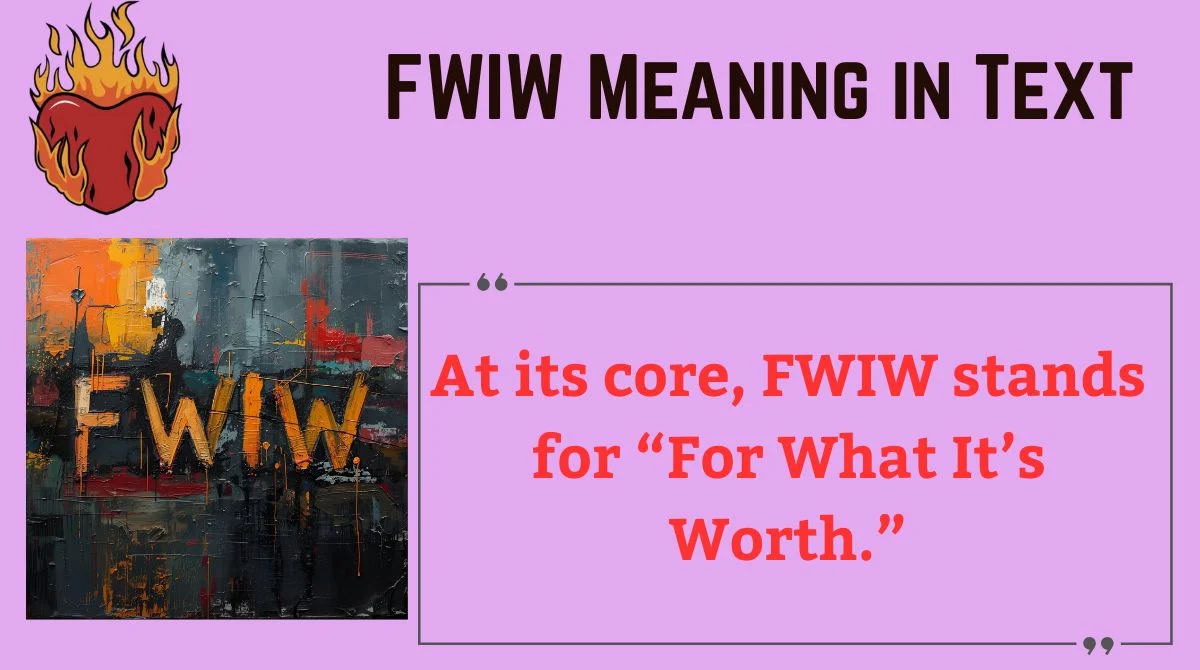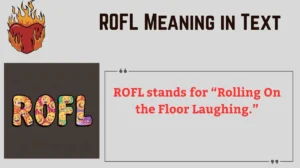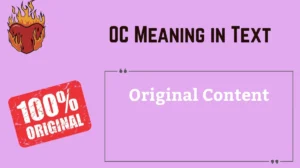Have you ever received a message that ended with “FWIW” and paused for a second trying to figure out what it really meant? You’re not alone.
This small but powerful acronym pops up everywhere — from casual group chats to professional emails. And while it looks simple, its meaning and tone can change depending on context.
This guide breaks it all down for you. We’ll explore what FWIW means in text, where it came from, how it’s used today, what to avoid, and how to respond like a pro.
What FWIW Actually Means
At its core, FWIW stands for “For What It’s Worth.”
It’s often used to share an opinion, piece of information, or suggestion — while showing a bit of humility. Instead of forcing your point of view, you’re offering it gently.
✅ Example:
FWIW, I think the blue design looks more modern.
Here, the speaker isn’t demanding a change. They’re just adding a thought — for whatever value it may bring.
Key ideas behind “For What It’s Worth”:
- Softens the tone of a statement.
- Shows humility or respect for other opinions.
- Signals that the message is a suggestion, not a demand.
- Keeps conversations open and polite.
A Bit of Background: Where “FWIW” Came From
The phrase “for what it’s worth” isn’t new. It was part of everyday spoken English long before the internet. People used it to downplay their own opinion modestly — almost like saying, “Take it or leave it.”
When online messaging exploded in the 1990s and early 2000s, FWIW became a shorthand on forums, emails, and chatrooms. Over time, it spread to texting, social media, and even professional communication.
Quick Timeline: Evolution of “FWIW”
| Era | Context | How It Was Used |
|---|---|---|
| Pre-Internet | Spoken English | Casual conversations, advice |
| Early Internet (1990s) | Forums, email | Technical discussions, opinions |
| 2000s | SMS, IM | Friend-to-friend chats |
| 2010s–2020s | Social media, workplace chats | Common softener in opinions |
| 2025 | All digital communication | Widely used across cultures |
This evolution shows how a simple phrase transformed into a digital communication staple.
How People Use FWIW Today
Tone is everything with FWIW. Depending on how it’s delivered, it can sound humble, sarcastic, supportive, or even passive-aggressive.
The intent usually falls into one of these categories:
- Humble suggestion: “FWIW, I think this idea has potential.”
- Soft disagreement: “FWIW, I saw a different report.”
- Polite disclaimer: “FWIW, I’m not an expert, but here’s what I know.”
- Sarcasm: “FWIW, that was a great plan.” (🙃 usually tone-dependent)
Texting & Social Media
In texting and social media posts, FWIW appears as a casual tone softener.
Examples:
- “FWIW, I liked the old logo better.”
- “FWIW, I already sent the files.”
- “FWIW, she’s actually right.”
Why people use it here:
- To avoid sounding bossy in casual conversations.
- To offer opinions without sparking arguments.
- To signal “this is just my two cents.”
Gaming & Online Communities (Discord, Twitch, Reddit)
In gaming chats and live streaming platforms, tone moves fast. FWIW is a quick, lightweight way to share tips or feedback without starting drama.
Examples:
- “FWIW, the boss attack is easier if you use the shield first.”
- “FWIW, that strat worked for us last round.”
Why gamers use it:
- Keeps the tone chill during competitive play.
- Encourages teamwork without being pushy.
- Fits well with short, fast-paced messages.
Work & Professional Settings
This is where FWIW can be powerful — or risky. In professional chats, it helps soften suggestions, especially when talking to senior colleagues or giving feedback.
Examples:
- “FWIW, the data shows a 12% drop after week 3.”
- “FWIW, we might want to run another test before launch.”
Best use cases at work:
- Brainstorming sessions.
- Offering data-backed opinions.
- Suggesting alternatives.
What to avoid:
- Using it too often — it can make you sound uncertain.
- Using it in legal, contractual, or very formal emails.
📝 Pro tip: In corporate settings, pair FWIW with clear facts. That way, your message sounds both polite and credible.
Real-Life Examples of FWIW in Sentences
Let’s look at how the same acronym can shift tone depending on context:
| Tone | Sentence | Meaning |
|---|---|---|
| Friendly | “FWIW, I think your idea’s solid.” | Encouragement |
| Neutral | “FWIW, I sent the email last night.” | Factual info |
| Sarcastic | “FWIW, that was amazing planning.” | Criticism with irony |
| Professional | “FWIW, the metrics improved after launch.” | Polite observation |
| Diplomatic | “FWIW, I see where you’re coming from.” | Empathy or soft disagreement |
Common Misconceptions About FWIW
Because it can be used in many ways, FWIW often gets misunderstood. Here are the biggest misconceptions:
- ❌ “FWIW is rude.”
Not true. It usually softens tone. It only sounds rude if paired with sarcasm. - ❌ “FWIW is outdated.”
Nope. It’s still one of the most common acronyms in digital communication. - ❌ “FWIW always means disagreement.”
Wrong again. It can be supportive, neutral, or even encouraging. - ❌ “FWIW is only for casual chats.”
It’s also used in professional and academic conversations — with the right tone.
FWIW vs. Similar Phrases & Alternatives
You’ll often see other acronyms that overlap with FWIW. But they’re not the same.
| Acronym | Full Form | Tone | When to Use |
|---|---|---|---|
| FWIW | For What It’s Worth | Soft, humble | Sharing opinions gently |
| IMO | In My Opinion | Neutral | General opinion |
| TBH | To Be Honest | Direct, blunt | Strong opinions |
| FYI | For Your Information | Informative | Sharing info, not opinion |
| ICYMI | In Case You Missed It | Informative | Highlighting past info |
👉 Think of FWIW as the “polite cousin” of IMO and TBH.
How to Respond to FWIW (and When Not To)
How you reply depends on the intent behind the message.
✅ Good response examples:
- “Thanks, that actually helps.”
- “Good point — I hadn’t thought of that.”
- “Appreciate it.”
- “Makes sense, FWIW too!”
❌ When not to overreact:
Sometimes, people use FWIW casually — no reply is needed if it’s not a conversation starter.
🧠 Tip: If the message feels sarcastic, respond carefully. A neutral, fact-based reply can diffuse tension.
Regional & Cultural Nuances
FWIW can mean slightly different things depending on where you are or who you’re talking to.
- 🇺🇸 U.S. English: Often polite, casual, or soft suggestion.
- 🇬🇧 U.K. English: Sometimes used with dry or subtle sarcasm.
- 🌏 Global English (ESL): Can be misunderstood as dismissive.
For non-native speakers, it may sound like “I don’t care” — which isn’t usually the intent. That’s why tone and context matter so much.
Is FWIW Ever Offensive?
By itself, no. But the way it’s delivered can make it feel passive-aggressive.
For example:
- “FWIW, I told you so.” → ❌ Rude, sarcastic tone.
- “FWIW, we could try another approach.” → ✅ Polite suggestion.
Situations where it can backfire:
- Heated arguments.
- When the other person already feels defensive.
- In formal business negotiations.
When in doubt, rephrase or avoid FWIW in high-stakes conversations.
Using FWIW in Professional Settings: Do’s & Don’ts
Using FWIW wisely can make you sound collaborative. Overusing it can make you seem unsure.
| ✅ Do’s | ❌ Don’ts |
|---|---|
| Use it with data to soften your opinion. | Don’t overuse it in every email. |
| Use it to show respect for other views. | Don’t use it when making firm decisions. |
| Keep it polite and concise. | Don’t pair it with sarcasm in work chats. |
| Use it in brainstorming or casual Slack channels. | Don’t use it in legal or formal letters. |
📌 Pro Tip: If you need to sound more confident, skip FWIW and make your point directly.
Frequently Asked Questions (FAQs)
What does FWIW mean in text?
FWIW stands for “For What It’s Worth.” It’s used to gently offer an opinion, suggestion, or extra information without sounding pushy.
Is FWIW formal or informal?
FWIW leans informal but can be used professionally if the tone is polite and the context is casual (like Slack or email threads).
Is FWIW offensive?
Not by itself. It can feel sarcastic if used with a negative tone, but in most cases, it’s neutral or even polite.
How do you respond to FWIW?
Acknowledge the input with something simple like “Thanks,” “Good point,” or “Makes sense.”
Can I use FWIW in business communication?
Yes, but sparingly. It works best in collaborative discussions, not in official documents or negotiations.
Key Takeaways & Final Thoughts
- FWIW = “For What It’s Worth.”
- It softens opinions and shows humility.
- Context and tone shape how it’s understood.
- It’s common across texting, gaming, and work chats.
- Misuse can make it sound passive-aggressive, so use it wisely.
Language isn’t just about what you say — it’s about how you say it. And FWIW is a perfect example of how a tiny acronym can carry a lot of weight.

Mark Peter is the creative mind behind RizzleLineLove.com, your go-to hub for witty, flirty, and downright hilarious pick-up lines. With a passion for blending humor and charm, Mark crafts content that sparks conversations, breaks the ice, and adds a playful twist to everyday moments.
Whether you’re looking to impress your crush, make your friends laugh, or spice up your social media captions, his work is all about helping you connect — one clever line at a time.



